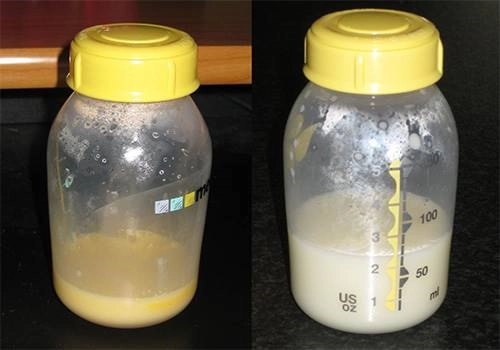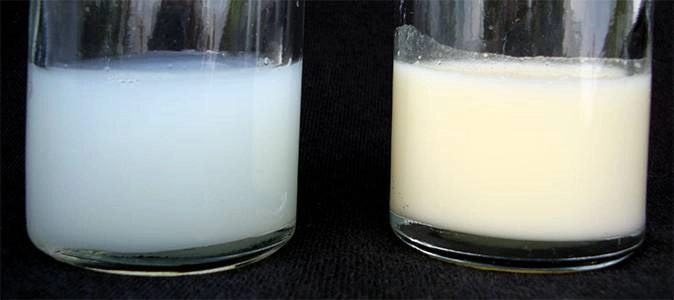Is your breast milk color normal? Sometimes yellow, sometimes white, sometimes green and sometimes even blue: nursing mothers can have a wide variety of breast milk colors!
Can your baby drink your breast milk whatever its color? Is your breast milk color indicative of its nutritional value? Let's look together at each possible color and what it means.
Below are helpful links so you can directly go to the color you're interested in:
- Is yellow breast milk normal?
- Is grey breast milk normal?
- Is blue breast milk normal?
- Is green breast milk normal?
- Is pink/brown breast milk normal?
- Is dark grey/black breast milk normal?
1. Yellow: is yellow breast milk normal?
This is a summary of a more detailed article about yellow breast milk. If you want all the possible reasons why your breast milk might be yellow, read the article.
Q: My daughter is almost 2 months old. My milk has always been very yellow. My mother tells me that this means my milk is not nutritious enough. Is this the case? If so how can I improve so that my milk turns white?
A: After a baby is born, its mother's milk goes through three natural stages, each with its own nutritional characteristics.
The milk at the very beginning is called "colostrum". It is very yellow and even close to orange in color because it's full of beta-carotene, which your baby transforms in vitamin A. This stage lasts for 2 to 3 days.
After colostrum, the milk goes through a "transitional" stage that lasts about 2 weeks. During this transition period the color of your milk changes from yellow to white. When the milk is completely white, it is considered "mature" milk, the third and last stage of the evolution of your breast milk.

Colostrum (left) versus mature milk (right)
Yellow breast milk could also occur if you or your baby are sick, in which case the additional white blood cells and antibodies in your milk will make it yellow.
Other reasons for yellow breast milk might be because your milk is richer in fat/lipids than usual or because your diet is rich in beta-carotenes.
For much more details about these reasons, read our dedicated article about yellow breast milk.
2. Grey/blue: is grey/blue breast milk normal?
Q: When I pump my milk looks very thin and has a grey/bluish color. Is this normal?
A: This might be due to the fact that you're not pumping for long enough. During a breastfeeding or pumping session, the amount of lipids in your breast milk gradually increases as time goes on. We refer to the milk at the beginning of a pumping session as "Foremilk": it tends to be thinner in texture and often has a grey/bluish hue. As your pumping goes on, your milk progressively becomes "Hindmilk": it becomes ticker, creamer and has a more white/yellowish tone. This is because it has much more fats/lipids in it than Foremilk. It is important that your baby doesn't only get Foremilk but Hindmilk as well. Lipids are essential to a baby's development.

Foremilk (left) versus Hindmilk (right)
Try lengthening your pumping session to see if you get a richer and whiter milk as time goes on. If your milk remains thin and grey nonetheless, consider consulting a lactation specialist. They may recommend you change your diet so that your milk becomes richer in lipids.
3. Green: is green breast milk normal?
Q: Sometimes my breast milk gets very green. It typically lasts for a couple of breastfeeding sessions and then it becomes white again. I'm just wondering if it's something that I should be concerned about?
A: Green breast milk is usually caused by eating a lot of green or blue food, such as spinach and algae with high vitamin content. Foods containing blue dye or eating vitamin B supplements may also turn breast milk green. Although it can be shocking to see, this is typically nothing to worry about.
4. Blood-tinged breast milk: is pink/brown breast milk normal?
Q: When I was pumping, some blood started to come out instead of milk. I was shocked. The blood mixed into the bottle and the milk took on a brown color. I immediately stopped pumping and threw the milk away as I do not want my baby to drink blood. What is the possible cause of bleeding? Shall I still continue to breastfeed?
Blood in breast milk is typically nothing to worry about. Your baby's digestive system can handle it as soon as we're speaking relatively small amounts. The two most common causes of blood in breast milk are cracked nipples and "rusty pipe syndrome". More common with first-time moms during the first few days of breastfeeding, rusty pipe syndrome is due to your body getting used to the extra blood flow needed in your breasts. It typically gets resolved on its own within a few days and you shouldn't stop breastfeeding during that time period.
Blood in breast milk can also be due to other causes such as an internal trauma to your breasts or mastitis. In much rarer cases it may be caused by breast cancer. In any cases it's always a good idea to mention blood in your milk to your health care provider. They'll best be able to advise on the possible cause in your case.
5. Dark grey or black breast milk: is it normal?
Q: I've started taking a new medication and my breast milk has now turned almost black, is this normal? Can I continue breastfeeding without danger to my baby?
A: You should stop breastfeeding, black or dark grey breast milk is not normal at all! It may be due to antibiotics intake (such as Norocycline or Minocycline). If you take any medication, please tell your doctor that you are breastfeeding and stop taking the drug. Wait for a few days afterwards before breastfeeding again so as to ensure the medication is out of your system.
When to be worried
Variations in the color of your breast milk are most often caused by your diet and it's likely nothing to be worried about. Only black or dark grey breast milk are colors you should be really worried about. If that happens, stop breastfeeding immediately and switch your little one to formula.
In general if you have any concerns about your breast milk, you should never hesitate to contact your doctor or a lactation specialist. They will be able to evaluate the situation and judge if you should come in for an examination.
Article tags: Breastfeeding and maternity








